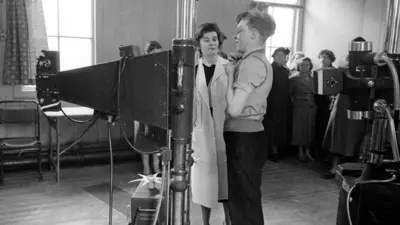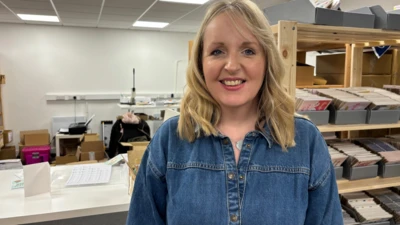We've updated our Privacy and Cookies Policy
We've made some important changes to our Privacy and Cookies Policy and we want you to know what this means for you and your data.
Fire tests in Fermanagh all about the science of safety
- Author, Louise Cullen
- Role, 91╚╚▒¼ News NI
It has taken six months of planning and weeks of work to get the nine-deep, criss-crossed wooden beams into perfect position - and it's all set to go up in smoke.
The structure will form the basis of an experimental fire test, sponsored by the European Commission.
Ulster University's Prof Ali Nadjai said they are trying to update knowledge and "enhance public safety".
The study will pay particular attention to "transient heating".
Transient heating is when the fire is hotter in one part of a building, or space, than another.
This has huge implications for the safety of those in the building, those tackling the fire and of the actual building itself.
Miles of green cable
If separate metal beams are exposed to different heat levels, for example, that could cause a collapse.
Being able to predict how a blaze is likely to behave is a vital part of fire safety - hence more than 300 sensors buried in and around the fire being observed at Garvary, County Fermanagh.
There are miles of fine green cable, connecting each sensor in the open structure to the freight container serving as an operations centre.
"Every one's identified and the end of the test we're able to log the temperature in each specific zone," said Maurice McKee, an engineer with the Fire Safety Engineering Research and Technology (FireSERT) Centre at Ulster University.
"We're able to trace that back and plot how the fire affected each specific area."
This is the first of three fire tests to be carried out at the site in Garvary.
The makeshift building has just one wall at the back of the fire, a roof over it and support beams throughout.
It mimics what the experts call a large compartment - like a department store - so they can observe how it travels through the space.
The next tests will look at how the fire moves and behaves in an enclosed space and in a partially-open compartment, like an apartment building.
"The fire will control everything," Prof Nadjai said.
"These three scenarios will give us the most understanding, the most interesting results to analyse and look at and bring new concepts of design in construction."
Prof Nadjai has big plans for the information he and his researchers will gather over the next few weeks.
"We have to prepare a document, in order to develop the knowledge of the architecture, the building control, the engineers."
So a series of short-lived fires in a corner of County Fermanagh could help make the world a safer place for us all.
Top Stories
More to explore
Most read
Content is not available








